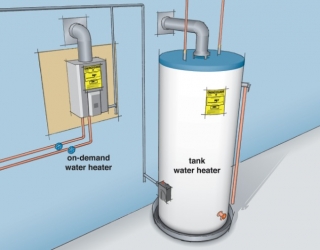By Samantha Bresler | Fri, May 23, 14
The products that we use every day (Appliances, Electronics, Lighting, etc.) may sound mundane and not at all dangerous, but when accumulated, their electrical consumption contributes to climatic and environmental damage. One of those products that continues to draw large quantities of power is the home’s hot water heater. Up until recently we had no alternative – no opportunity to realize energy, financial, and environmental benefits. Now we have an opportunity to rebel against the status quo electric resistance water heater with an efficient Heat Pump Water Heater (HPWH). So go on. Be a rebel.
In past blogs we’ve suggested not to wait till the old water heater breaks down and to replace it with an efficient option. We can assure you that taking cold showers aren’t very appealing in the interim. Purchasing a business-as-usual water heater could make the heating bills unnecessarily high. If you live in the Northeast or Mid-Atlantic, odds are your region or state offers rebates on Heat Pump Water Heaters. HPWH, unlike standard electric resistance water heaters, function much like a refrigerator in reverse. HPWHs pull heat from the surrounding air and force it, at a higher temperature, into a tank to hot water. So rather than generating heat, HPWHs extract heat from the ambient air and use it to heat water. This method requires less energy, which takes less money from you and is more environmentally-friendly.
 Yet despite the energy saving potential from HPWHs, this emerging technology faces several challenging hurdles. Issues around savings assumptions, consumer and market awareness, and cost are compounded by issues related to distribution and the building trades. In 2012, NEEP has developed the Northeast and Mid-Atlantic Heat Pump Water Heater Market Strategies Report which focuses on a deliberate approach to market adoption, cognizant of the pitfalls that other emerging technologies have experienced.
Yet despite the energy saving potential from HPWHs, this emerging technology faces several challenging hurdles. Issues around savings assumptions, consumer and market awareness, and cost are compounded by issues related to distribution and the building trades. In 2012, NEEP has developed the Northeast and Mid-Atlantic Heat Pump Water Heater Market Strategies Report which focuses on a deliberate approach to market adoption, cognizant of the pitfalls that other emerging technologies have experienced.
Recently, the HPWH industry is all abuzz given that the new Federal Standards (i.e. the national baseline) will be ramped up to the current ENERGY STAR specification, forcing ENERGY STAR to revise their current specification. While ENERGY STAR is currently updating the specification for HPWH, many feel that the new specifications are not aggressive enough for the efficiency programs. Additionally, given the temperature conditions of these products in the Northeast, the region is supportive of manufacturers reporting their compressor cutoff requirements. Overall, the Residential Water Heaters Federal Standard effective in 2015 is great news because the entire country will save approximately 3.3 quads of energy, $63 billion in energy savings, and avoid 172.5 million metric tons of carbon dioxide (equivalent to 33.8 million automobiles).
The planet needs people that aren’t afraid of doing things a little differently. So if you want to enjoy the benefits of energy-efficient hot water running in your household, think about installing a HPWH. Start with ENERGY STAR, know your rebate opportunities, and learn more about the temperature performance capabilities of these heaters.
